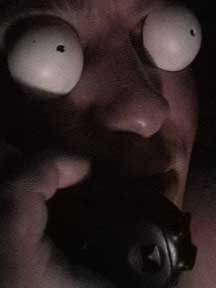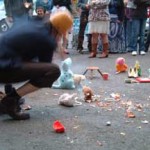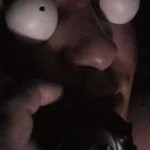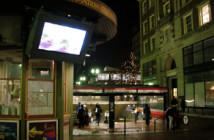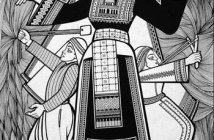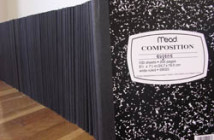The Allston parking lot setting for the most recent TEST 7, felt like a throwback to some long gone American summer. Students were milling, music was playing, and the macadam could have still been hot although the air was getting really cold. There were U-hauls and other vehicles, a set of dumpsters, and a small crowd. Sandi Schaefer was already in mid-mince in “combing out the (k)nots (Yee Haul).” Schaefer had stuffed her denim trousers and gingham top with potatoes and was producing them one-by-one from her person and peeling them down to nothing. She was walking around stiffly, completely overstuffed. The immediate radius was already littered with thick peelings.
TEST, for those who aren’t yet up to speed, is the name of a series of evenings of performance work by both local and visiting artists, produced approximately bimonthly and generally staged cheek-by-jowl. Information tends to be circulated over e-mail rather than the web in order to keep venues without permits under the radar of any bored law enforcement professional. TEST’s location moves around the city. The work at TEST is of course sometimes bad, sometimes great, and sometimes gloriously uneven…(I admit it, giving an eyewitness report makes me feel pret-ty savvy.)
The first short performance was Bryce Kauffman’s “Hamster.” Kauffman and a team of boy artists rapidly assembled a person-sized ring from wooden components that were circled by aluminum-like tarpaper. The team then raised the wheel to vertical and Kauffman darted inside like he was doing double dutch. The top arc, however, immediately caved and within seconds the shape folded to the ground. The artist kept a poker face throughout the audience reaction - oohs, aahs, and sympathetic murmurs - to what was obviously a botched attempt. He then jumped up and down on the object and deposited the smithereens in a dumpster over several trips. We watched the silent tantrum.
A performance by Dirk Adams followed. He carried out a cardboard box labeled FREE, set it down in the middle of the lot, unpacked its contents of stuffed animals and the odd collectible, and proceeded to enact a prop-driven performance with more than a hint of slapstick: “But can it be fixed into a thing of beauty.” After some fluffing and primping of the objects, Adams began to rip, pull, and apply hammers and other implements to the toys. The performance continued rolling headlong down this slippery slope until it became clear that every piece would be spectacularly busted. A purple panda started to ooze a liquid that I initially assumed was a carcinogen but later realized, when the artist took a swig, was actually a plastic bottle of booze that had been planted in advance. Most of the stuffed toys had been given surprise treatments like this, including jokey ones (a plushy piece of corn had been filled with a box of corn starch), which turned their destruction simultaneously splendid and smart alecky. For a conclusion, Adams stacked the remains of the toys in an unspectacular totem. In the end, the precise location of the “fix” that the title alluded to was entirely ambiguous. I decided that these named reparations were best found in the artist’s invention of combustible innards to improve his rumpled props.
The most compelling piece of the evening was Deva Eveland’s sustained performance, “Command Center.” A non-descript car with Illinois plates and blacked out windows was parked in the lot, and each viewer needed to actually open a car door and slip inside to experience the work. From afar, these entrances were as horribly seductive as any pre-kidnapping scene on television. The inside of the vehicle meanwhile was very quiet, and its use as a space that was imminently not drivable created a weird, survivalist vibe. In the front seat, there was a tiny, surveillance-style monitor that displayed close-up footage of the artist; it seemed that his chest was bare and his eyes were covered by egg-shaped prostheses with pinpoint pupils. A walkie-talkie in the car allowed passengers to question Eveland in this noticeably claustrophobic location. When we tried it, the response was an urgently whispered, “this is the Command Center. I want to assure you that I am in complete control of this vehicle.” The blurred image of the artist moved in delayed time with his insistent broadcasts and it suddenly became obvious that he was shut inside the car’s trunk. I surprised myself by laughing out loud at the realization and relief. No matter how ridiculous or bullying our questions to the artist then became, the only response was his repeated assurance that he was in complete command, not to question him, and not to think that the atmosphere of his location was anything but ideal for commanding the vehicle. Such interactions inspired giggles from everyone in the car, even on subsequent visits. The familiarity of Eveland’s personal propaganda, especially as issued from such a close remove, was pathetic. Yet each of the two times one of my fellow passengers threatened him with popping the trunk and opening up his sham of a command center, the threat was always made in terms of pranking the artist, not freeing him from his miserable condition. These broken dialectics were beautifully conceived, both insidious and hilarious.
The evening also featured performances from Rebecca Scheckman, who interpreted an excerpt from Anna Karenina using her body, candles, and pain, and J’Ambiance, a group from Lowell whose multimedia composition was built with cyclical images and cyclical sound - parts ambient, parts Koyaanisqatsi.
Sandy Huckleberry closed the evening with a brief burst of a performance, "YOU-Haul." She turned her car keys over to a volunteer driver, hopped on her hood, directed the audience to a thick rope, and commanded us to follow its natural application. About fifteen people merrily towed her, and her car, out to the brink of the lot and the end of the night.
- Dirk Adams, But can it be fixed into a thing of beauty, (photo by Jeff Huckleberry)
- Deva Eveland, Command Center, (photo from artist)
Links:
TEST
TEST 7 was performed at the International Bicycle Center parking lot in Allston on June 18, 2005

